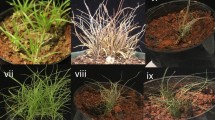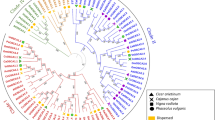Abstract
When subjected to drought conditions, some organisms enter a state of suspended animation known as anhydrobiosis1, surviving for indefinite periods until rehydration allows them to resume normal metabolism. We have identified a gene in the anhydrobiotic nematode Aphelenchus avenae that is upregulated in response to desiccation stress and whose encoded protein shares sequence similarity with a late-embryonic gene that is induced in many plants when they are deprived of water. This finding suggests that animals and plants that undergo anhydrobiosis may use common protective strategies against dehydration, and provides a unifying insight into the mechanism of anhydrobiosis.
Similar content being viewed by others
Main
A characteristic feature of anhydrobiotic organisms is their synthesis of high concentrations of non-reducing sugars during the induction of anhydrobiosis1. For example, A. avenae accumulates large amounts of trehalose in response to dehydration, and this correlates with its desiccation tolerance2. Trehalose protects membranes and proteins from desiccation damage by replacing structural water1, and contributes to the formation of an intracellular organic glass3 which is thought to stabilize the cell's contents. In anhydrobiotic plants, sucrose has a similar function4.
However, several lines of evidence indicate that non-reducing sugars alone are not sufficient to confer a state of anhydrobiosis, and that further adaptations are required5,6. A class of proteins known as LEA (for 'late embryogenesis abundant') proteins accumulate in response to water deficit in many plants, and these are particularly abundant in anhydrobiotic plants such as the resurrection plant Craterostigma plantagineum, and in maturing seeds and pollen7. We therefore investigated whether similar genes are present in A. avenae.
We found that several genes are upregulated in A. avenae nematodes undergoing anhydrobiosis during exposure to 90% relative humidity for 24 hours. Of particular interest was a strongly induced transcript with a length of about 675 bases (Fig. 1a, b), which encodes a predicted protein of 143 residues. The sequence of this protein indicates that it is a member of the group-3 subclass of LEA proteins8; it contains at least four copies of a characteristic 11-mer motif, and further echoes of this motif are present throughout the sequence (Fig. 1c).
a, Expression of the A. avenae late-embryonic gene Aavlea1 in response to desiccation stress, as revealed by northern blotting using an Aavlea1 probe: lane 1, control RNA from fresh untreated nematodes; lane 2, RNA from nematodes exposed to 90% relative humidity for 24 h. b, Same blot, but this time hybridized with an 18S rRNA probe as a loading control. c, Local alignment (P = 2 e−19) of a 121-amino-acid overlap between the predicted sequences of Aavlea1 (GenBank accession number AF423069) and an embryonic protein from the European white birch (Betula pendula; accession number S39475). S39475 was the most closely related LEA-3 sequence to Aavlea1 that we were able to detect in the GenBank database. There are at least four copies of the characteristic 11-mer LEA-3 motif (highlighted).
The group-3 LEA motif has been proposed to form an amphipathic α-helix that directs the oligomerization of the protein9. These proteins are extremely hydrophilic and are resistant to denaturation by heat — prompting suggestions that they help to prevent damage by water stress, for example by acting as hydration buffer, molecular chaperone, ion sink or membrane stabilizer1,9.
Sucrose glasses are stabilized in vitro by interaction with a purified group-3 LEA protein from Typha latifolia pollen10. Non-reducing sugars and LEA proteins may therefore act synergistically4,10 to promote the formation of a stable 'bioglass' in the cytoplasm of anhydrobiotic plants and in desiccation-tolerant seeds and pollen — the bioglass may trap fragile biological mol-ecules in time and space, and preserve them from desiccation damage. If the newly identified LEA protein in A. avenae also stabilizes trehalose glasses in this way during desiccation, the bioglass model for anhydrobiosis can be extended to include anhydrobiotic animals.
Genomic11 and partial protein12 sequence information indicates that LEA proteins may be used by other nematodes as a defence against water stress. The genomes of some microorganisms also contain sequences that encode LEA-like proteins (although expression of these has not yet been demonstrated11), including the desiccation-tolerant Deinococcus radiodurans, which also encodes enzymes for the biosynthesis of trehalose. A bioglass strategy for anhydrobiosis could be widely used in biological systems and may have originated in ancient cell types that were exposed to water stress.
References
Crowe, J. H., Hoekstra, F. A. & Crowe, L. M. Annu. Rev. Physiol. 54, 579–599 (1992).
Madin, K. A. C. & Crowe, J. H. J. Exp. Zool. 193, 335–346 (1975).
Crowe, J. H., Carpenter, J. F. & Crowe, L. M. Annu. Rev. Physiol. 60, 73–103 (1998).
Sun, W. Q. & Leopold, A. C. Comp. Biochem. Physiol. 117A, 327–333 (1997).
Higa, L. M. & Womersley, C. Z. J. Exp. Zool. 267, 120–129 (1993).
García de Castro, A. & Tunnacliffe, A. FEBS Lett. 487, 199–202 (2000).
Ingram, J. & Bartels, D. Annu. Rev. Plant Physiol. Plant Mol. Biol. 47, 377–403 (1996).
Dure, L. et al. Plant Mol. Biol. 12, 475–486 (1989).
Dure, L. Plant J. 3, 363–369 (1993).
Wolkers, W. F. et al. Biochem. Biophys. Acta 1544, 196–206 (2001).
Dure, L. Protein Pept. Lett. 8, 115–122 (2001).
Solomon, A., Salomon, R., Paperna, I. & Glazer, I. Parasitology 121, 409–416 (2000).
Author information
Authors and Affiliations
Corresponding author
Ethics declarations
Competing interests
The authors declare no competing financial interests.
Rights and permissions
About this article
Cite this article
Browne, J., Tunnacliffe, A. & Burnell, A. Plant desiccation gene found in a nematode. Nature 416, 38 (2002). https://doi.org/10.1038/416038a
Issue Date:
DOI: https://doi.org/10.1038/416038a
This article is cited by
-
LEA motifs promote desiccation tolerance in vivo
BMC Biology (2021)
-
Advanced technologies for the preservation of mammalian biospecimens
Nature Biomedical Engineering (2021)
-
The Aphelenchus avenae genome highlights evolutionary adaptation to desiccation
Communications Biology (2021)
-
Extreme-tolerance mechanisms in meiofaunal organisms: a case study with tardigrades, rotifers and nematodes
Hydrobiologia (2020)
-
Structural properties and cellular expression of AfrLEA6, a group 6 late embryogenesis abundant protein from embryos of Artemia franciscana
Cell Stress and Chaperones (2019)
Comments
By submitting a comment you agree to abide by our Terms and Community Guidelines. If you find something abusive or that does not comply with our terms or guidelines please flag it as inappropriate.




